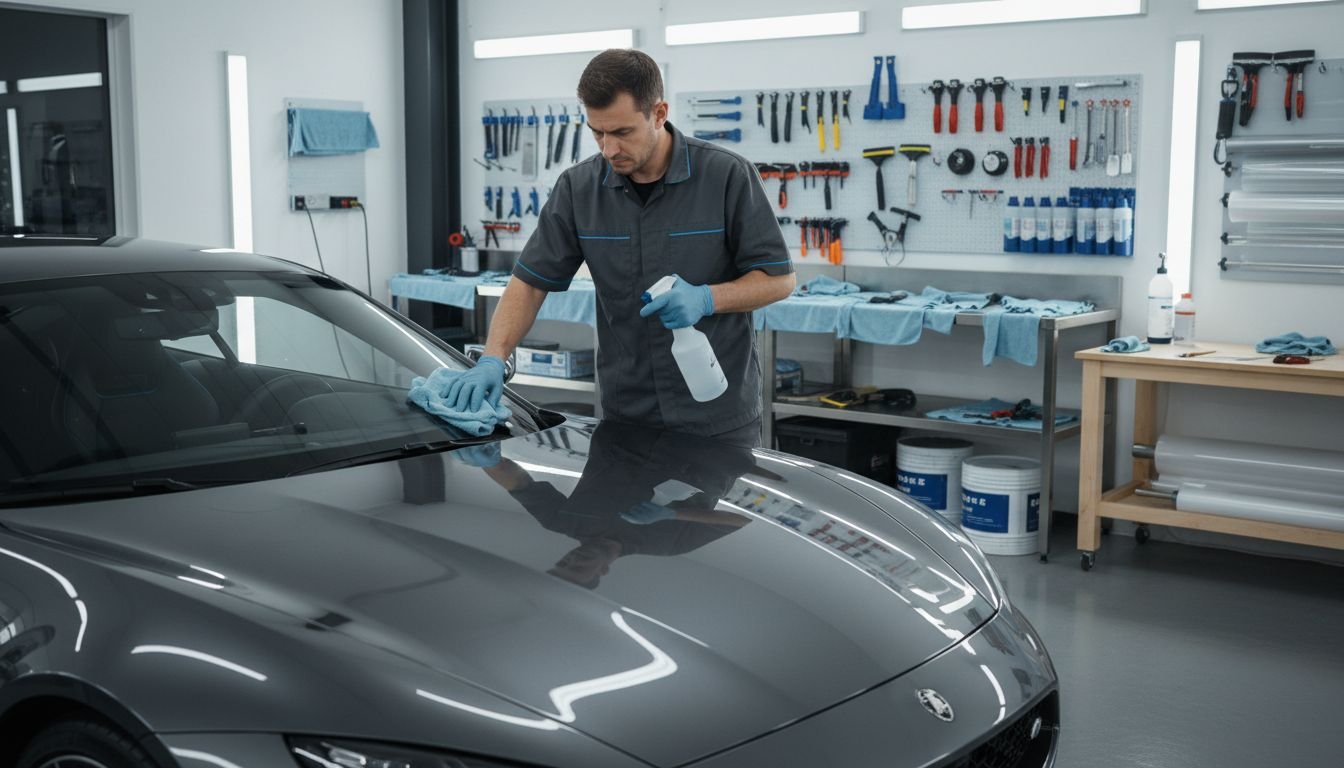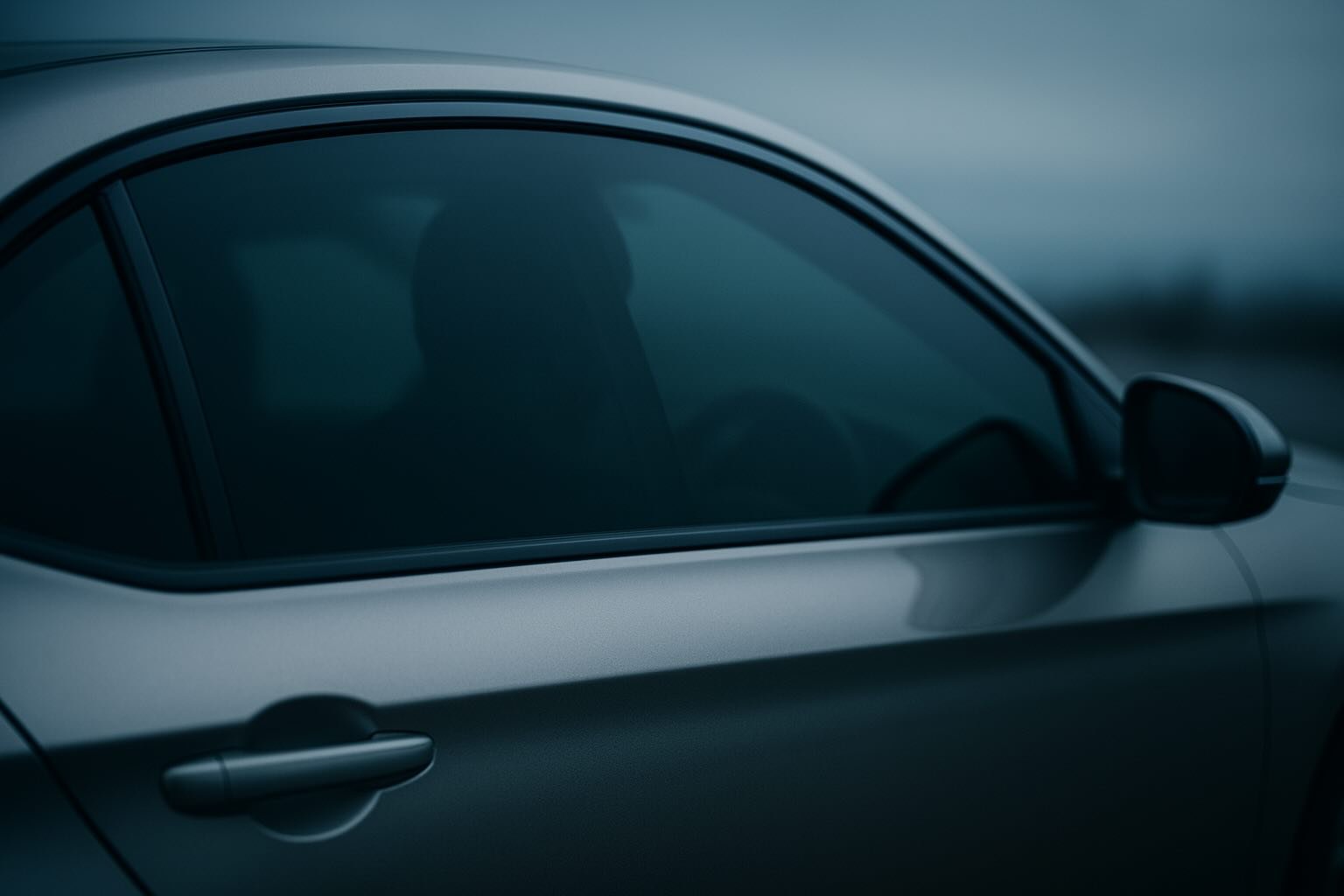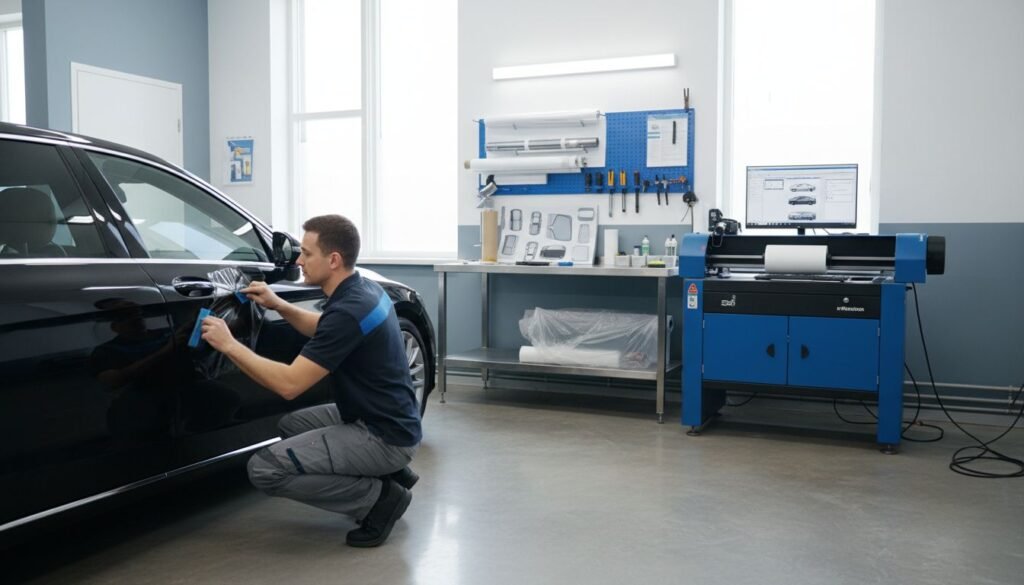
Did you know that a thin window tint film can block up to 99 percent of harmful UV rays while keeping your car noticeably cooler? With more drivers looking for comfort, privacy, and safety, the demand for advanced window tinting has surged. Understanding how window tinting works reveals practical ways it shields interiors, improves driving experience, and tackles legal concerns without sacrificing style or visibility.
Table of Contents
- What Is Window Tinting and How It Works
- Types of Window Tint Films for Vehicles
- Professional Window Tinting Installation Process
- Legal Regulations and Compliance Globally
- Benefits, Risks, and Common Pitfalls
Key Takeaways
| Point | Details |
|---|---|
| Window Tinting Benefits | Enhances vehicle comfort by reducing heat, blocking UV rays, and minimizing glare, while improving privacy and aesthetics. |
| Types of Window Tint | Various film types such as dyed, metalized, hybrid, carbon, and ceramic, each with specific performance characteristics and aesthetic options. |
| Installation Process | Professional installation requires meticulous steps including surface preparation, precision cutting, careful application, and curing for optimal results. |
| Regulatory Compliance | Adhering to local tinting laws regarding Visible Light Transmission (VLT) and reflectivity is crucial to avoid penalties and ensure safety. |
What Is Window Tinting and How It Works
Window tinting is a sophisticated automotive customisation process that transforms ordinary vehicle glass into a high-performance protective barrier. According to research from AAA, window tinting involves applying a thin, specialized film to the interior side of vehicle windows, designed to control light transmission and enhance driving comfort.
The core mechanism of window tinting revolves around its unique material composition. As documented by Wikipedia, window films are typically crafted from polyester and treated with advanced coatings that enable multiple functional properties. These films work by strategically reflecting or absorbing solar energy, which results in several significant benefits:
- Reducing interior heat buildup
- Blocking harmful ultraviolet (UV) radiation
- Decreasing glare for improved visibility
- Protecting vehicle interiors from sun damage
- Enhancing driver and passenger privacy
The effectiveness of window tinting depends critically on the film’s Visible Light Transmission (VLT) percentage, which determines how much light passes through the film. Professional installers can select from various tint grades to meet specific performance requirements, whether for aesthetic preferences, thermal management, or legal compliance. Types of Window Tint: Guide for Installers and Dealers 2025 offers comprehensive insights into selecting the right window tint for different applications.
Types of Window Tint Films for Vehicles
Professional window tint installers have access to a diverse range of film technologies, each designed to meet specific performance and aesthetic requirements. According to research from AAA, vehicle window tint films can be categorised into six primary types, each offering unique advantages for automotive applications.
The most common window tint film types include:
Dyed Window Tint: An entry-level option that uses a layer of dye to absorb solar heat and reduce glare. It provides a non-reflective appearance and is typically the most budget-friendly choice.
Metalized Window Tint: Incorporates metallic particles that reflect heat and UV rays. While effective at strengthening windows, this type may potentially interfere with electronic signals.
Hybrid Window Tint: Combines dyed and metalized layers to create a balanced performance profile, offering improved heat rejection and durability.
Carbon Window Tint: Features carbon particles that block infrared light and reduce heat, delivering a sophisticated matte finish without signal interference.
Ceramic Window Tint: Represents the premium tier of window films. Using ceramic particles, it provides superior heat rejection and UV protection while maintaining electronic signal transparency. Understanding The Science of UV & IR Rejection in Automotive Window Films offers deeper insights into this advanced technology.
Each film type presents unique benefits, allowing installers to recommend solutions tailored to individual client needs, vehicle types, and performance expectations.
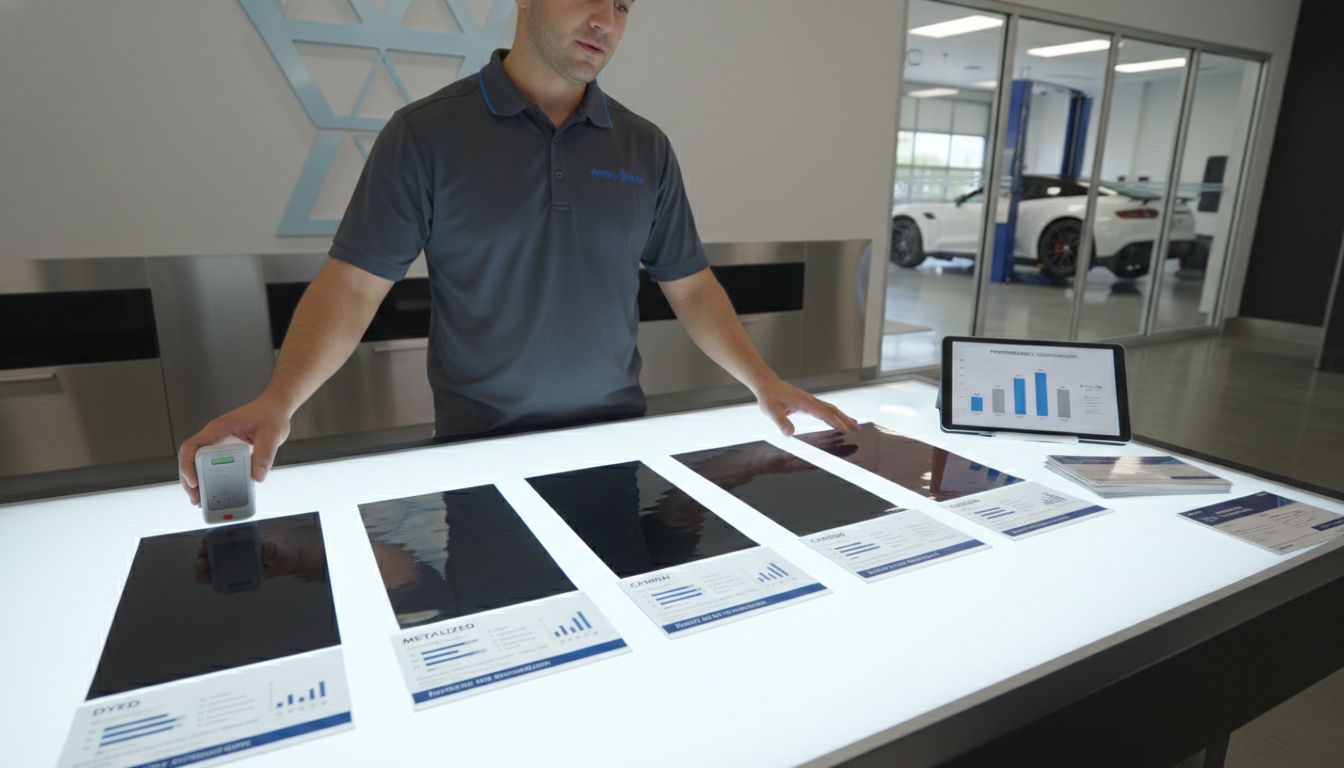
Here’s how the main vehicle window tint film types compare:
| Film Type | Heat Rejection | UV Protection | Signal Interference | Appearance |
|---|---|---|---|---|
| Dyed | Moderate | Good | None | Non-reflective, dark |
| Metalized | High | Excellent | Possible | Slightly reflective |
| Hybrid | High | Excellent | Low risk | Subtle reflectivity |
| Carbon | Very high | Excellent | None | Matte, dark finish |
| Ceramic | Superior | Superior | None | Neutral, clear/dark |
Professional Window Tinting Installation Process
Window tinting is a precise craft that demands meticulous attention to detail and professional-grade techniques. According to automotive experts, the installation process involves a series of carefully executed steps designed to ensure optimal film performance and aesthetic quality.
The professional window tinting installation typically follows these critical stages:
Surface Preparation: Thoroughly cleaning the window surfaces is the foundational step. This involves removing all dirt, dust, and contaminants using specialized automotive cleaning solutions and lint-free cloths to create a perfectly clean surface.
Precise Measurement and Cutting: Accurate film sizing is crucial. Installers use professional-grade tools to measure each window precisely and cut the tint film to match the exact dimensions. Heat Shrinking Window Tint: 2025 Guide for Installers provides advanced techniques for handling complex window shapes.
Careful Application: The tint film is carefully applied to the interior side of the window, using specialized techniques to prevent air bubbles, wrinkles, and misalignment. Professional installers use squeegees, heat guns, and precise hand movements to ensure smooth, seamless application.
Curing and Finishing: After application, the film requires a specific curing period. During this time, the adhesive bonds completely with the glass, and any remaining moisture evaporates. This stage is critical for achieving long-lasting, high-quality window tint installation.
Successful window tinting demands not just technical skill, but also patience, precision, and a deep understanding of different film types and application techniques.
Legal Regulations and Compliance Globally
Window tinting regulations represent a complex landscape of safety, privacy, and legal considerations that professional installers must carefully navigate. According to research from Wikipedia, automobile window tinting laws vary significantly across different jurisdictions, with most regions implementing specific restrictions to ensure road safety and driver visibility.
The primary focus of these regulations centers on Visible Light Transmission (VLT) percentages, which measure the amount of light allowed through vehicle windows. Typical regulatory parameters include:
- Front windshield: Often limited to minimal tinting, usually above the manufacturer’s AS-1 line
- Front side windows: Stricter transmission requirements, typically mandating 70-50% light passage
- Rear side and back windows: Generally allow darker tints, with more lenient VLT requirements
Interestingly, factory tint presents its own unique regulatory considerations. As documented in Wikipedia, factory-installed privacy glass typically ranges between 15-26% VLT, which may already approach or exceed legal limits in some jurisdictions. Professional installers must carefully assess existing factory tint when considering additional window film applications.
Complex regulations extend beyond light transmission, potentially including restrictions on:
- Reflectivity of window films
- Color of tint materials
- Specific medical exemptions for darker tints
- Requirements for certification and professional installation
How Window Tint Works: Essential Guide for Auto Professionals 2025 provides additional insights into navigating these intricate legal landscapes. Professional window tint installers must remain continuously updated on local and regional regulations to ensure full legal compliance and customer satisfaction.
Benefits, Risks, and Common Pitfalls
Window tinting is a nuanced service that offers significant advantages while simultaneously presenting professional installers with critical challenges to navigate. According to research from AAA, the practice involves a delicate balance between performance, aesthetics, and potential risks.
The primary benefits of window tinting include:
- Heat Reduction: Blocking solar energy to decrease interior temperatures
- UV Protection: Shielding occupants and vehicle interiors from harmful ultraviolet radiation
- Glare Minimization: Reducing visual strain from direct sunlight and headlight reflections
- Enhanced Privacy: Limiting visibility into the vehicle
- Aesthetic Enhancement: Improving the vehicle’s overall visual appeal
However, professional installers must be acutely aware of potential risks and common pitfalls:
- Legal Compliance Challenges: Non-adherence to local tinting regulations can result in substantial fines and mandatory film removal
- Visibility Limitations: Excessively dark tints can severely impair driver visibility, particularly during night driving
- Signal Interference: Certain metallic window films may disrupt electronic signals, affecting GPS, radio, and mobile communications
- Installation Quality Concerns: Poor application techniques can lead to:
- Bubble formation
- Premature peeling
- Reduced film effectiveness
Understanding The Science of UV & IR Rejection in Automotive Window Films provides deeper insights into managing these complex considerations. Successful window tinting demands not just technical skill, but a comprehensive understanding of material science, legal requirements, and customer expectations.
Elevate Your Window Tint Installations with Precision and Ease
The detailed craftsmanship discussed in “Window Tinting Explained: Complete Guide for Installers” highlights the challenges of achieving perfect cuts and seamless application. From exact measurement to careful film application, professional installers face pressure to minimise waste and deliver flawless results every time. If you want to reduce errors, improve efficiency and maintain top-tier quality, embracing the right tools makes all the difference.
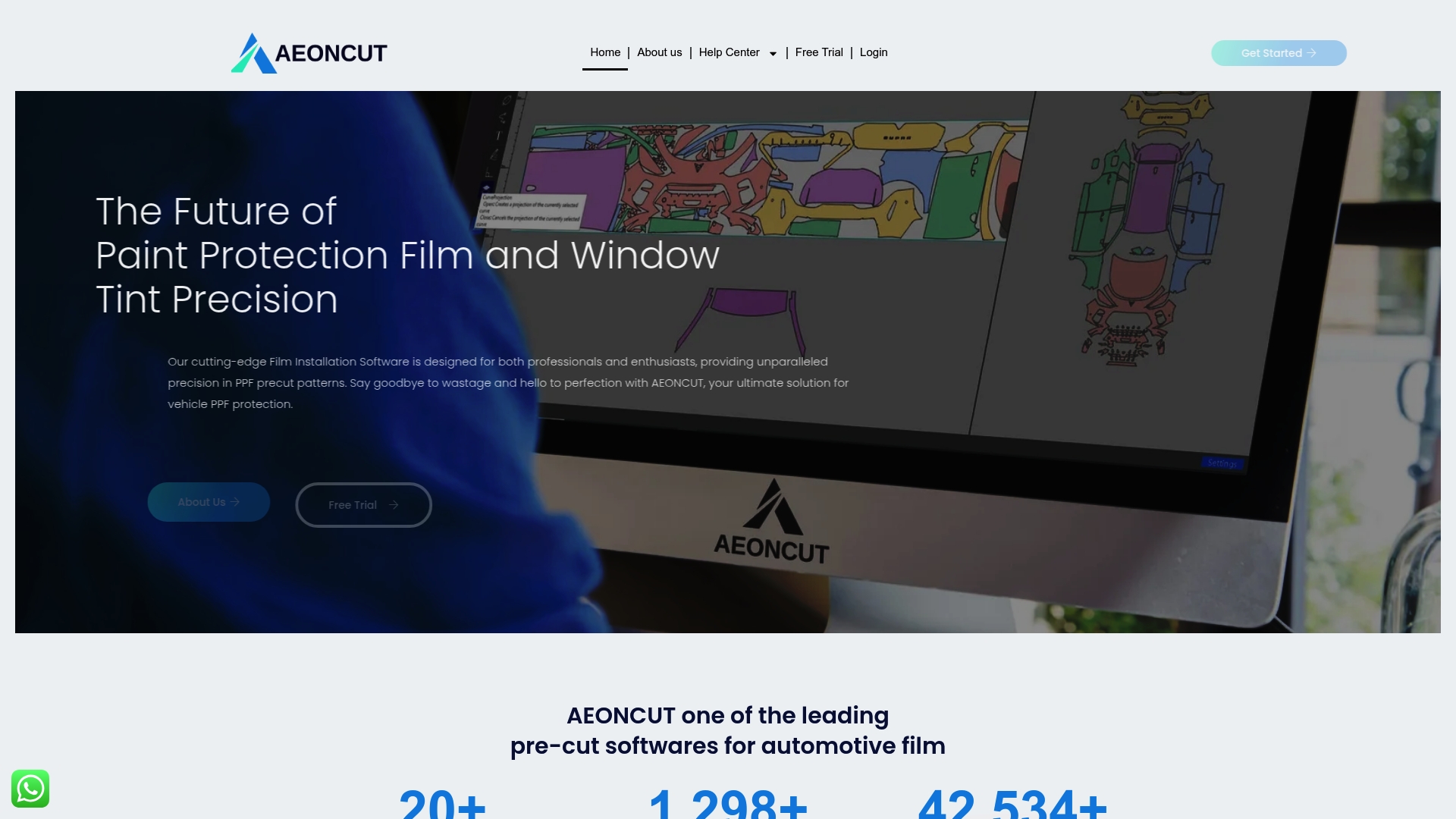
Discover how the window Tint – AEONCUT PPF Pre-cut Cutting software transforms your workflow with AI-powered auto-nesting and a vast pattern library tailored for automotive tint films. Designed for professionals who demand accuracy and speed the AEONCUT software ensures your pre-cut patterns fit perfectly the first time. Don’t let imprecise cuts or time-consuming manual processes hold you back. Take the next step towards mastering your craft by exploring AEONCUT’s innovative solutions at https://aeoncutsw.com and start delivering exceptional tint installations with confidence.
Frequently Asked Questions
What is window tinting and how does it work?
Window tinting is the application of a thin, specialized film to the interior side of vehicle windows, designed to control light transmission, reduce heat buildup, block UV radiation, and enhance privacy. It works by either reflecting or absorbing solar energy, providing various benefits tailored to vehicle needs.
What are the different types of window tint films available for vehicles?
The main types of window tint films include Dyed, Metalized, Hybrid, Carbon, and Ceramic films. Each type offers unique benefits, such as varying levels of heat and UV protection, aesthetic qualities, and potential for electronic signal interference. For instance, Ceramic films provide superior heat rejection without signal interference.
What is the process for professional window tinting installation?
The professional installation process typically involves several key steps: surface preparation by cleaning the windows, precise measurement and cutting of the tint film, careful application to avoid air bubbles and wrinkles, and a curing period for the adhesive to bond completely with the glass.
What are the legal regulations regarding window tinting?
Window tinting regulations vary widely and mainly focus on the Visible Light Transmission (VLT) percentages, which determine how much light can pass through the windows. Common restrictions include maximum tint levels on front windshields and side windows, as well as potential guidelines on reflectivity and color. Compliance with local regulations is crucial to avoid fines and ensure safety.
Recommended
- How Window Tint Works: Essential Guide for Auto Professionals 2025 – AEONCUT PPF Pre-cut Cutting software
- Types of Window Tint: Guide for Installers and Dealers 2025 – AEONCUT PPF Pre-cut Cutting software
- What is Window Tint? Essential Guide for Tinting Pros 2025 – AEONCUT PPF Pre-cut Cutting software
- How to Read Tint Percentage: A Practical Guide for 2025 – AEONCUT PPF Pre-cut Cutting software


